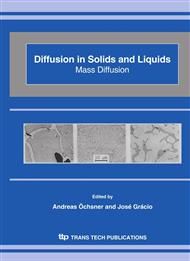p.522
p.531
p.542
p.554
p.563
p.575
p.586
p.592
p.600
Mass Transport Modelling in Porous Media Using Delay Differential Equations
Abstract:
In this work the application of delay differential equations to the modelling of mass transport in porous media, where the convective transport of mass, is presented and discussed. The differences and advantages when compared with the Dispersion Model are highlighted. Using simplified models of the local structure of a porous media, in particular a network model made up by combining two different types of network elements, channels and chambers, the mass transport under transient conditions is described and related to the local geometrical characteristics. The delay differential equations system that describe the flow, arise from the combination of the mass balance equations for both the network elements, and after taking into account their flow characteristics. The solution is obtained using a time marching method, and the results show that the model is capable of describing the qualitative behaviour observed experimentally, allowing the analysis of the influence of the local geometrical and flow field characteristics on the mass transport.
Info:
Periodical:
Pages:
586-591
Citation:
Online since:
October 2006
Price:
Сopyright:
© 2006 Trans Tech Publications Ltd. All Rights Reserved
Share:
Citation:


